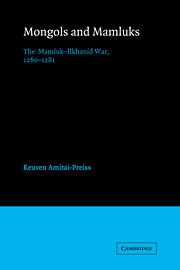Book contents
- Frontmatter
- Contents
- List of illustrations
- Preface
- List of abbreviations
- Notes on dates and transliteration
- Introduction
- 1 The historical background
- 2 The battle of ʿAyn Jālūt
- 3 The formulation of anti-Īlkhānid policy
- 4 The search for a second front
- 5 Military and diplomatic skirmishing
- 6 The secret war
- 7 Baybars's intervention in Seljuq Rūm
- 8 Baybars's posthumous victory: the second battle of Homs (680/1281)
- 9 The Mamluk–Īlkhānid frontier
- 10 Mamluks and Mongols: an overview
- Maps
- Genealogical Tables
- Glossary
- Bibliography
- Index
10 - Mamluks and Mongols: an overview
Published online by Cambridge University Press: 23 November 2009
- Frontmatter
- Contents
- List of illustrations
- Preface
- List of abbreviations
- Notes on dates and transliteration
- Introduction
- 1 The historical background
- 2 The battle of ʿAyn Jālūt
- 3 The formulation of anti-Īlkhānid policy
- 4 The search for a second front
- 5 Military and diplomatic skirmishing
- 6 The secret war
- 7 Baybars's intervention in Seljuq Rūm
- 8 Baybars's posthumous victory: the second battle of Homs (680/1281)
- 9 The Mamluk–Īlkhānid frontier
- 10 Mamluks and Mongols: an overview
- Maps
- Genealogical Tables
- Glossary
- Bibliography
- Index
Summary
Now it is the custom of the Tartars never to make peace with men who kill their envoys, until they have taken vengeance on them.
John of Plano CarpiniIn this study, the origins and early course of the Mamluk–Īlkhānid war have been examined through narrative history interspersed with chapters of a monographic nature. Having looked at the war in some detail, it is appropriate to conclude this study with an overview of the subject, keeping in mind two paramount questions: why did this war continue, and why were the Mamluks successful in stopping the Mongols?
In recent studies, Professor J.M. Smith, Jr. and Dr. D.O. Morgan have offered fresh insights into the nature of the Mamluk–Mongol war. Professor Smith, in a wide-ranging article, analyzes the weaponry and tactics of both sides, and embarks on a technical discussion on the strengths and limitations of the Mongol and Mamluk horses. In the first section of this chapter, his approach will be considered and elaborated upon. In the second section, the question of the logistical problems encountered by the Mongols in Syria, as raised independently by Professor Smith and Dr. Morgan, will be examined. In the final section, I will suggest explanations for both the ongoing war and the Mamluk success in stopping the Mongols.
Troops and tactics compared
Professor Smith's discussion, the most detailed and systematic study of the subject yet attempted, can be summarized as follows: the Mongol army was a people's army, that is, all Mongol adult males were enlisted.
- Type
- Chapter
- Information
- Mongols and MamluksThe Mamluk-Ilkhanid War, 1260–1281, pp. 214 - 235Publisher: Cambridge University PressPrint publication year: 1995

